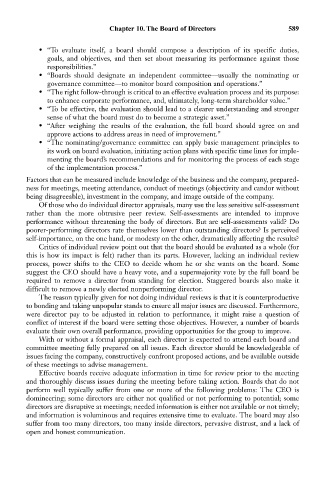Page 603 - Bruce Ellig - The Complete Guide to Executive Compensation (2007)
P. 603
Chapter 10. The Board of Directors 589
• “To evaluate itself, a board should compose a description of its specific duties,
goals, and objectives, and then set about measuring its performance against those
responsibilities.”
• “Boards should designate an independent committee—usually the nominating or
governance committee—to monitor board composition and operations.”
• “The right follow-through is critical to an effective evaluation process and its purpose:
to enhance corporate performance, and, ultimately, long-term shareholder value.”
• “To be effective, the evaluation should lead to a clearer understanding and stronger
sense of what the board must do to become a strategic asset.”
• “After weighing the results of the evaluation, the full board should agree on and
approve actions to address areas in need of improvement.”
• “The nominating/governance committee can apply basic management principles to
its work on board evaluation, initiating action plans with specific time lines for imple-
menting the board’s recommendations and for monitoring the process of each stage
of the implementation process.”
Factors that can be measured include knowledge of the business and the company, prepared-
ness for meetings, meeting attendance, conduct of meetings (objectivity and candor without
being disagreeable), investment in the company, and image outside of the company.
Of those who do individual director appraisals, many use the less sensitive self-assessment
rather than the more obtrusive peer review. Self-assessments are intended to improve
performance without threatening the body of directors. But are self-assessments valid? Do
poorer-performing directors rate themselves lower than outstanding directors? Is perceived
self-importance, on the one hand, or modesty on the other, dramatically affecting the results?
Critics of individual review point out that the board should be evaluated as a whole (for
this is how its impact is felt) rather than its parts. However, lacking an individual review
process, power shifts to the CEO to decide whom he or she wants on the board. Some
suggest the CEO should have a heavy vote, and a supermajority vote by the full board be
required to remove a director from standing for election. Staggered boards also make it
difficult to remove a newly elected nonperforming director.
The reason typically given for not doing individual reviews is that it is counterproductive
to bonding and taking unpopular stands to ensure all major issues are discussed. Furthermore,
were director pay to be adjusted in relation to performance, it might raise a question of
conflict of interest if the board were setting those objectives. However, a number of boards
evaluate their own overall performance, providing opportunities for the group to improve.
With or without a formal appraisal, each director is expected to attend each board and
committee meeting fully prepared on all issues. Each director should be knowledgeable of
issues facing the company, constructively confront proposed actions, and be available outside
of these meetings to advise management.
Effective boards receive adequate information in time for review prior to the meeting
and thoroughly discuss issues during the meeting before taking action. Boards that do not
perform well typically suffer from one or more of the following problems: The CEO is
domineering; some directors are either not qualified or not performing to potential; some
directors are disruptive at meetings; needed information is either not available or not timely;
and information is voluminous and requires extensive time to evaluate. The board may also
suffer from too many directors, too many inside directors, pervasive distrust, and a lack of
open and honest communication.

